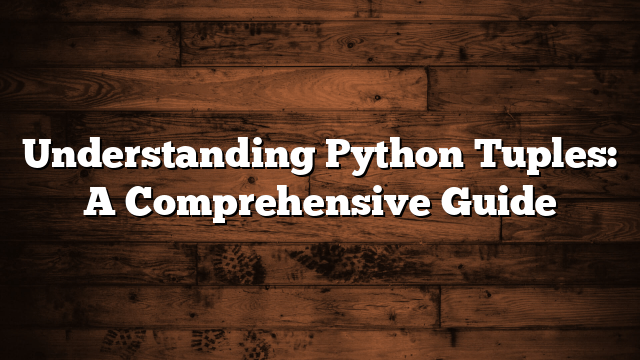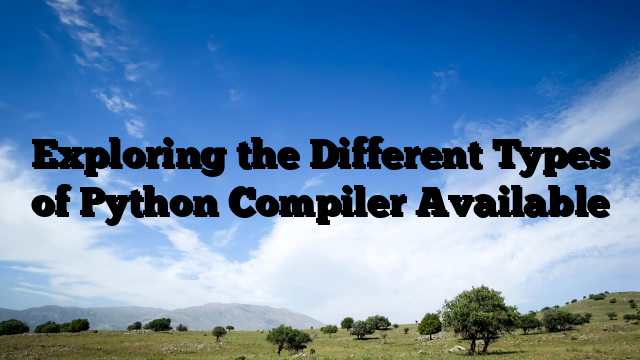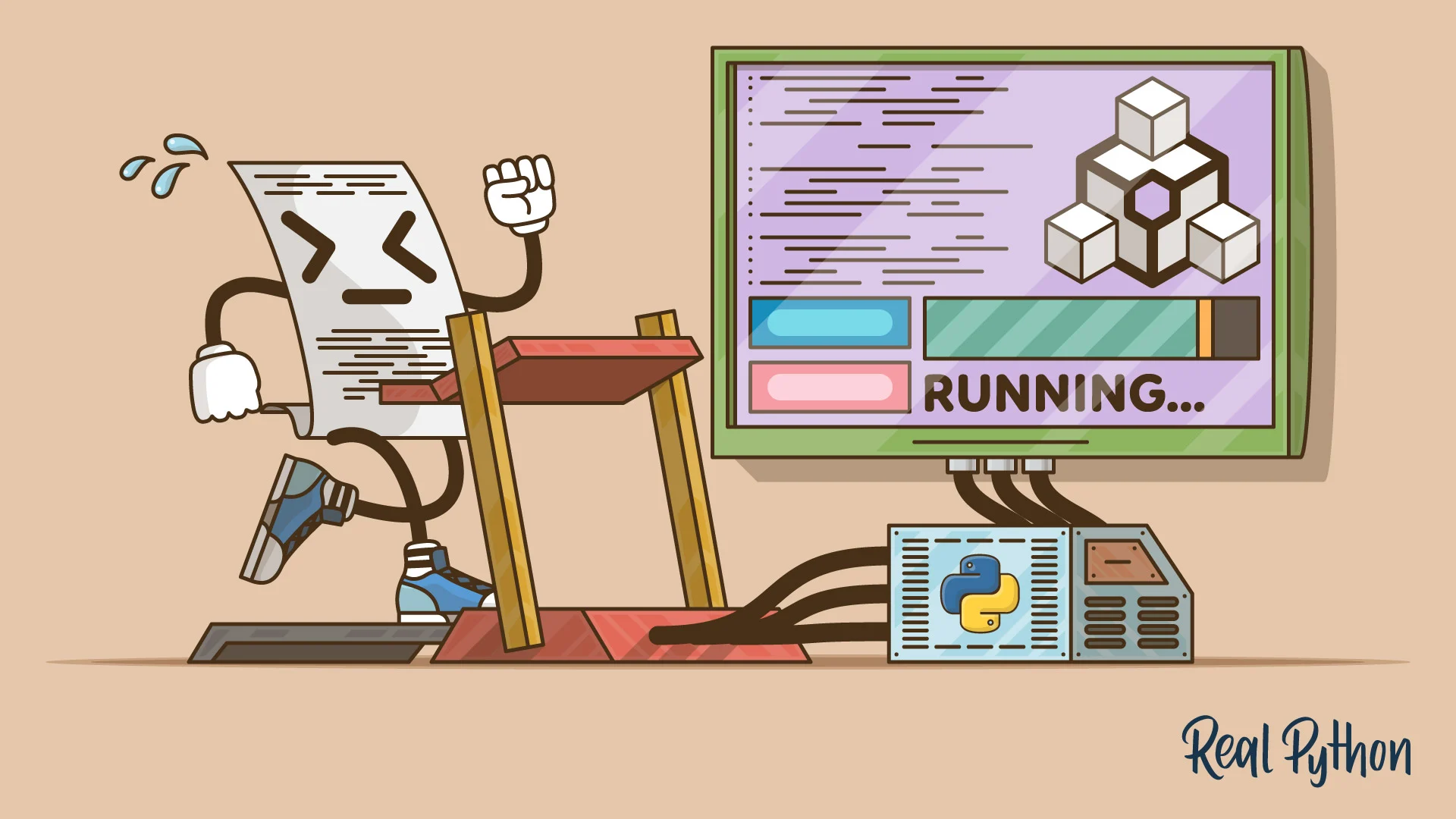- Exploring the Amazing Python Features
- Understanding Memory Management in Python: A Comprehensive Guide
- Exploring the Benefits of Python Programming
- Exploring the Best IDE for Python Programming
- Java or Python: Which Language Holds the Key to Your Programming Success?
- PHP vs Python: Which Language is Best for Your Project?
- From Bugs to Brilliance: Harnessing Python Exceptions for Powerful Coding
- Types of inheritance in python
- How to Create an Android App with Python
- Python vs C++: Uncovering the Best Programming Language for Your Needs
- How should I start learning Python?
- Python Dictionary: A Comprehensive Guide to Understanding and Using Dictionaries
- Introduction to Python Generators: What They Are and How to Use Them
- A Comprehensive Guide to Understanding Python else if Statements for Optimal Decision Making
- Boost Your Programming Skills with Python NumPy: An In-Depth Exploration of Its Features
- Exploring the Different Types of Python Compiler Available
- Understanding Python Tuples: A Comprehensive Guide
- Python List: A Comprehensive Guide to Working with Lists in Python
- Exploring Logical Operators in Python: A Comprehensive Guide
- Exploring the Different Types of Python Operators: A Comprehensive Guide
- A Comprehensive Guide to Python Datatypes
- Introduction to Python for Beginners
- Python Download: Your Comprehensive Guide to Getting Started
- how to comment out multiple lines in python
Are you looking to get started with Python programming? Python is a powerful, versatile language that is perfect for beginners. This beginner’s guide will provide you with the information you need to get started with Python, including an overview of the language, its features, and how to write basic programs. With this guide, you’ll be able to quickly learn the basics of Python and begin writing your own programs in no time.
Understanding the Basics of Python
How should I start learning Python?
Python is a powerful and versatile programming language that is used in a wide variety of applications. It is an excellent choice for beginners and experienced programmers alike. If you are interested in learning Python, it is important to understand the basics of the language before diving into more complex topics.
The first step in learning Python is to install the language on your computer. Python is available for free on the official website, and there are several versions available. Once you have installed Python, you can start writing your first program. Python is an interpreted language, which means that you can run your code directly from the command line without needing to compile it.
Once you have written your first program, you can start exploring the language further. Python has a large standard library that contains many useful functions and modules. You can also use third-party libraries to extend the functionality of Python. Additionally, there are many tutorials and resources available online to help you learn Python.
When learning Python, it is important to understand the basic concepts of the language. These include variables, data types, functions, classes, and control flow. Understanding these concepts will help you write better programs and become a more proficient programmer.
Python also has several popular frameworks and libraries that can be used to develop applications. These include Django, Flask, and TensorFlow. Learning how to use these frameworks and libraries will help you develop more complex applications.
Finally, it is important to practice writing code in Python. Writing code regularly will help you become more familiar with the language and develop your skills. You can find many online coding challenges and tutorials to help you practice.
Learning Python can be a rewarding experience. With a little effort and dedication, you can become a proficient programmer in no time.
Installing and Setting Up Python
How should I start learning Python?
Learning Python is a great way to get started with coding. Python is a versatile programming language that can be used for a variety of tasks, from data analysis to web development. To get started, you’ll need to install and set up Python on your computer.
Installing Python is a straightforward process. Depending on your operating system, you can either download the installer from the official Python website or use a package manager like Homebrew. Once you have the installer, you can follow the instructions to install Python on your computer.
Once Python is installed, you can start setting it up. This includes setting up a text editor or IDE, configuring the environment variables, and installing any necessary packages or libraries. You can also configure the Python interpreter to use a specific version of Python.
To start learning Python, you can begin by reading tutorials and guides online. There are many resources available, including books, online courses, and interactive tutorials. You can also find plenty of open source projects to work on and get familiar with the language.
Once you have a basic understanding of Python, you can start exploring more advanced topics. You can learn about object-oriented programming, functional programming, web development, data analysis, and more.
Learning Python can be a fun and rewarding experience. With the right resources and dedication, you can become a proficient Python programmer in no time.
Learning the Syntax of Python
How should I start learning Python? Learning the syntax of Python is a great way to start your journey into programming. Python is a powerful, versatile, and easy-to-learn programming language that can be used for a variety of tasks, from web development to data analysis.
Python is an interpreted language, meaning that it is read and executed by the computer line-by-line. This makes it easier to debug and understand than other languages. It also has a wide range of libraries and frameworks that can be used to create complex applications quickly and easily.
The syntax of Python is relatively simple and straightforward. It is based on the English language, so it is easy to read and understand. Python also has a large set of built-in functions and modules that can be used to perform common tasks.
The best way to learn the syntax of Python is to start by writing some simple programs. This will help you get familiar with the syntax and the various features of the language. You can also find many tutorials online that will help you understand the basics of Python.
Once you have a basic understanding of the syntax, you can start exploring the various libraries and frameworks available for Python. These will allow you to create more complex applications and websites.
Python is a great language to learn, and with a little practice, you can become an expert in no time. Start by learning the syntax and then explore the various libraries and frameworks available for Python. With a little practice, you will be able to create powerful applications quickly and easily.
Working with Variables and Data Types
How should I start learning Python? Learning Python is an excellent way to get started with coding and programming. Before you can begin writing code, however, it is important to understand the basics of working with variables and data types.
Variables are used to store data in a program. When you create a variable, you give it a name and assign it a value. The value can be a number, a string of characters, or a Boolean value (true or false). The data type of the variable determines how the data is stored and how it can be used.
The most common data types in Python are integers, floats, strings, and Booleans. Integers are whole numbers, floats are numbers with decimal points, strings are sequences of characters, and Booleans are true or false values. Other data types include lists, tuples, and dictionaries.
When you are working with variables and data types, it is important to understand how to assign values to variables and how to convert between data types. For example, you can convert an integer to a float by using the float() function. You can also use the str() function to convert a number to a string.
In addition to understanding the basics of variables and data types, it is also important to understand how to use them in your code. For example, you can use variables to store user input, store the results of calculations, and control the flow of your program.
Once you have a basic understanding of variables and data types, you can start writing code in Python. You can begin by writing simple programs to practice the basics, such as printing a message to the screen or asking the user for input. As you become more comfortable with the language, you can move on to more complex projects.
Learning Python is an exciting and rewarding experience. With a basic understanding of variables and data types, you can start writing code and creating your own programs.
Writing and Running Python Programs
How should I start learning Python? Learning Python is an exciting and rewarding experience. Python is a powerful, versatile, and popular programming language used by many developers around the world. Python is easy to learn and can be used to create a wide variety of applications, from web development to data science.
Writing Python programs is a great way to get started with programming. Python is a high-level language, meaning that it is easy to read and understand. It also has a large standard library, which provides a wide range of useful functions and libraries. This makes it easy to get started writing programs quickly.
When writing Python programs, it is important to understand the basic syntax and structure of the language. Python uses indentation to denote code blocks, and it is important to use the correct indentation when writing programs. Python also has a wide range of built-in data types, such as strings, integers, and lists. Knowing how to use these data types is essential for writing programs.
Once you understand the basics of Python, you can start writing more complex programs. Python has a wide range of libraries and frameworks that can be used to create powerful applications. These libraries and frameworks can be used to create web applications, graphical user interfaces, and more.
Python also has a wide range of tools that can be used to debug and optimize programs. Debugging is an important part of writing programs, and Python has a range of tools that can be used to find and fix errors in programs.
Learning Python is an exciting and rewarding experience. With a little bit of effort, you can quickly learn the basics of Python and start writing programs. Once you understand the basics, you can start exploring the wide range of libraries and frameworks available to create powerful applications.
Python is an incredibly powerful and versatile programming language that can be used for a variety of tasks. This beginner’s guide has provided an overview of the language, its syntax, and how to get started with Python. With the right resources and guidance, anyone can learn Python and start creating their own programs. With its wide range of applications, Python is a great language to learn for anyone looking to get into programming.

















